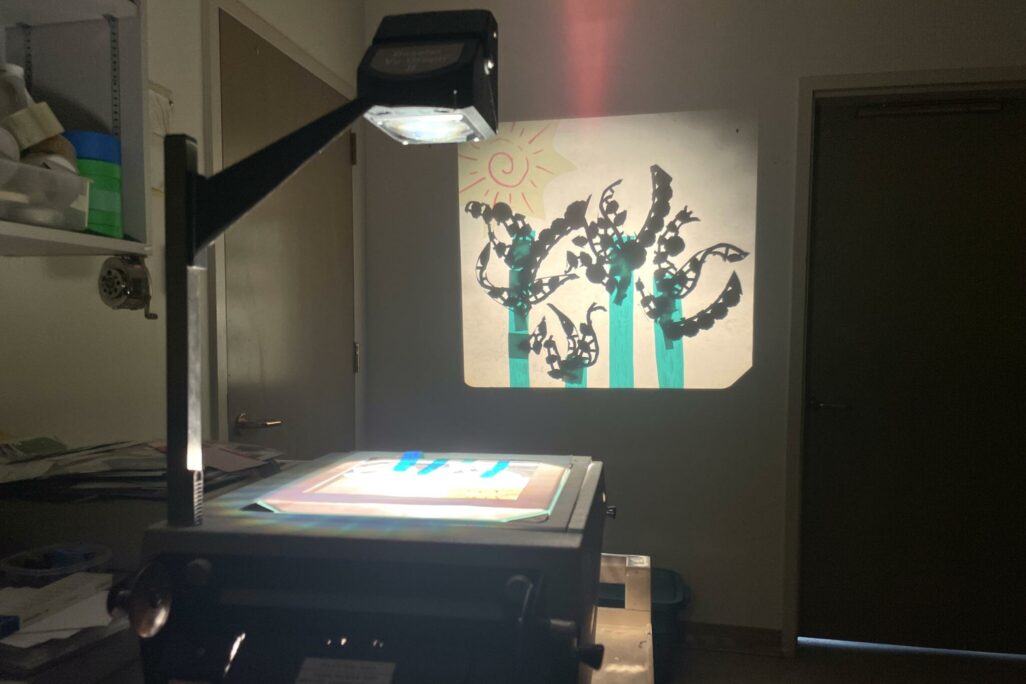Shadow Puppet Theatre
Share:
About the artwork
Create a shadow puppet theatre inspire by the work of Canadian artist, Shary Boyle: Outside the Palace of Me on view at the MacKenzie until 8 September 2024.
Tell your own stories with shadow puppets in our studio theatre! Create paper puppets that can then be brought to life using an overhead projector.

Shary Boyle, The Procession (detail), 2021, Stoneware, acrylic gouache, gold leaf. Courtesy of the artist and Patel Brown Gallery. Photo by John Jones.
About the Artist
Shary Boyle (b. 1972) is from the Scarborough area of Toronto. The recipient of a 2021 Honourary Doctorate of Fine Arts from her alma mater, Boyle graduated from the Ontario College of Art in 1994, developing a studio practice centered on figurative drawing, painting, and live performance. Creating deeply imaginative, idiosyncratic, and unsettling worlds, Boyle was an early innovator of live-drawing techniques using overhead projectors referencing shadow puppetry and cell animation. Boyle often collaborated with musicians and artists of other disciplines for these performances, activating her practice with a characteristically inclusive spirit.
Boyle began making sculpture in the late 1990s, modelling small polymer clay figures. Seemingly naïve and otherworldly, these flesh-like works incorporated fantastical imagery and often had an explicitly sexual aspect. She began working with ceramics in 2002, following a workshop on cast porcelain figurines and lace draping, approaches typically associated with elderly hobbyists. Boyle began researching the European history of the porcelain figurine, critically appraising its Enlightenment roots. The resulting works, exhibited at Toronto’s The Power Plant Contemporary Art Gallery in 2006, balanced highly refined and seductive surfaces with startling, sometimes disturbing imagery: a noblewoman holding her own bloody head in her hands, a lady consumed by delicate blossoms, a reclining damsel with an arching ouroboros of heads terminating between her legs.
Shary Boyle continues to work in sculpture, installation, drawing, and performance. Her multidisciplinary artworks were the subject of a major touring exhibition, Shary Boyle: Flesh and Blood in 2010–2011. She represented Canada at the 55th Venice Biennale in 2013 with Music for Silence, and co-curated the collaborative touring project Earthlings in 2017. Boyle has performed and exhibited extensively, from Los Angeles, New York, Paris, and Icheon, South Korea, to remote communities such as Dawson City, Yukon Territory, and Inuvik, Northwest Territories. Her work is widely represented in private and institutional collections, including the National Gallery of Canada, the Art Gallery of Ontario, the Montreal Museum of Fine Arts, and the Gardiner Museum.
Studio Activity
Create and share your own story with shadow puppets in our studio theatre!
Materials:
- Overhead projector
- Laptop
- Cellophane
- Clear masking tape
- Long wooden sticks
- Construction paper
- Glue sticks
- Scissors
- Markers
- Pencils, erasers, and sharpeners
- Stencils & magazines
Instructions:
- Select a theme that will inspire your puppet story. If you are running out of ideas, use some topics of the next possible options. Some possible options for themes could be: collaboration, animal care, environmental conservation, global warming, the way we treat each other and ourselves…
- Imagine at least two characters that could be part of the story.
- Choose your main character and secondary characters: Consider the story you want to tell and decide who your main character will be. What challenges will they face? Who else is involved in this story? Are these characters friends or foes of the main character? How will their paths intersect in the story?
- Create a shadow puppet from construction paper. Also, think about secondary characters who will help develop your story. Trace the outline of the shadow characters, cut them out, and glue them onto paper with a wooden stick attached as a handle.
- Now, start working on the structure of your puppet show. Draft your story in three acts; if you have extra time, you can add extra acts to sustain your story.
- Next, let’s add some special effects:
- BACKGROUND: Decide what kind of background your character will need in each act. Glue or stick it to your template. Use cellophane to create the background; remember to use both transparent or colored cellophanes. The background scenography of the story should be evident.
- SOUNDTRACK: Think of a special song that you want the gallery facilitator to play for you. It can be a silent show, or you can even create your own sounds with your voice to produce special effects.
- Play with creating shadows on the projection and acting out scenes with other puppet characters. Optionally, have parents, friends, and students take photos with the puppets.
- Visit the exhibition Shary Boyle: Outside the Palace of Me to experience the artist’s theatre and immersive stories!
Things to Think About
- Why are stories important to tell? How can stories help us examine topics that are important to us?
- How can you create a backdrop or landscape that can help tell your story? What would be the musical accompaniment for your story?

